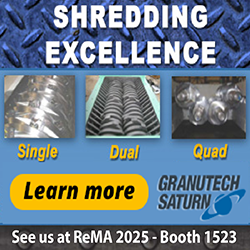The Office of the U.S. Trade Representative (USTR) is expected to release a notice in the Federal Register this week that lays out the full schedule for the implementation of modifications to the actions taken against China in Section 301 of the Trade Act. The Biden administration has not yet announced how it intends to handle the current exclusions, such as the exclusion that covers shredder wear parts, which are set to expire May 31, 2024.
“A lack of a permanent exclusion for shredder wear parts from the Section 301 tariffs puts our nation’s recycling and steelmaking sectors in a perilous situation,” said ReMA Assistant Vice President of International Trade and Global Affairs Adam Shaffer.
USTR released a report that provided a series of recommendations that includes significant tariff increases on imported products from Chinese sectors that directly compete with American manufacturers and U.S.-produced goods. These duty rate increases will apply primarily to products in strategic clean energy and green technology industries. Many of these tariff increases are preemptive and do not constitute action taken against products already entering the U.S. market.
For example, China exports little, if any, electric vehicles to the U.S. market because of the existing combined 27.5 percent tariff on those products, so increasing the Section 301 rate from 25 to 100 percent will only further deter Chinese exports to the U.S. Similarly on steel and aluminum, these products are already covered by Section 301 tariffs ranging from zero to 7.5 percent, in addition to the Section 232 tariffs on steel (25 percent) and aluminum (10 percent), as well as any trade remedy orders (AD/CVD) that are currently in effect.
The administration is taking a more nuanced, targeted approach, instead of a simple across-the-board tariff increase, as had been done during previous actions taken under Section 301. For example, USTR proposes tariff increases for the following Chinese imports:
- Battery Parts (non-Lithium-Ion batteries) – increase Section 301 tariff rate to 100 percent.
- Electric Vehicles – increase Section 301 tariff rate to 100 percent.
- Lithium-Ion EV/non-EV Batteries – increase Section 301 tariff rate to 25 percent.
- Other Critical Minerals – increase Section 301 tariff rate to 25 percent.
- Semiconductors – increase Section 301 tariff rate to 50 percent.
- Solar cells – increase Section 301 tariff rate to 50 percent.
- Steel and aluminum products – increase Section 301 tariff rate to 25 percent.
One key recommendation resulting from the review is the establishment of a new product exclusions process that will focus on machinery equipment used in domestic manufacturing. USTR has announced that it will only consider tariff lines that fall under Chapters 84 and 85 of the Harmonized Tariff Schedule of the U.S. (HTSUS) and while the proposed exclusions focus generally on finished machines, ReMA is seeking to include shredder wear parts in this list of exclusions.
In 2022, U.S. recyclers processed 137 million metric tons of materials, including approximately 70 million tons of iron and steel, and shredder wear parts are an essential component of the equipment that helps to ensure the competitiveness of the U.S. recycled materials industry.
Since the administration has opted not to entirely remove any products from the Section 301 tariff action, it is instead focused on providing exclusions where there is little or no domestic manufacturing production or capability. In ReMA’s submission to USTR in February, we highlighted that the foundries capable of producing most shredder wear parts primarily left the U.S. for China over the past two decades and that the tariff action did not result in the reshoring of the manufacturing of these components.
“U.S. recyclers rely on a steady supply of shredder wear parts to maintain operations that enable the U.S. to lead the world in the production of clean steel made with recycled content,” Shaffer said. “Permanently removing these products from the tariff list will ensure U.S. recyclers can provide U.S. steelmakers with the metal inputs they rely on for industry‐leading electric arc furnace (EAF) steel production, which is setting the standard for 21st century global steel production.”










